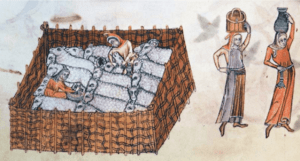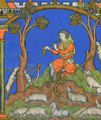Medieval English wool trade facts for kids
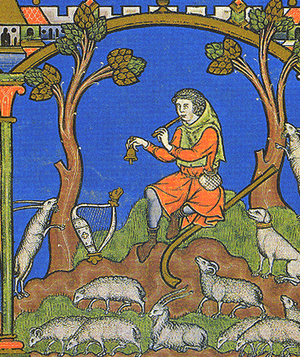
The medieval English wool trade was super important for England's economy during the Middle Ages. Imagine wool as the main engine driving everything! From about 1250 to 1350, selling wool was the biggest business in England.
This trade also changed how land was used. It led to "enclosure," where common lands were turned into private farms, often for sheep. This had big effects on people's lives.
You can still see signs of this rich history today. Many beautiful churches in places like East Anglia and the Cotswolds are called 'wool churches' because wealthy wool merchants paid for them. In London, there's a group called the Worshipful Company of Clothworkers, which started from the wool trade. And even now, the person in charge of the House of Lords (a part of the UK government) sits on a special chair called the Woolsack, which is stuffed with wool!
Contents
Wool in Early England
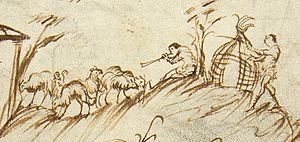
In early Anglo-Saxon times (around 450 to 650 AD), people made wool clothes for their own families. They used simple tools like warp-weighted looms for weaving. The way they spun and wove was similar to Roman times. They likely used fine, white wool from sheep brought from the Mediterranean, along with local wools.
They used natural dyes to color the wool. For example, woad made blue, and madder or lichens made reds and purples. Some fancy wool cloth, even with gold designs, has been found.
Around the 900s, new types of fabrics appeared. There isn't much proof of long-distance trade back then. But we know some special wools or cloths were traded. A famous letter from Charlemagne to Offa of Mercia even complained about the quality of English cloaks sent to France! By the 1000s, England had many sheep. Some wool was already being sold to German merchants. Some historians believe wool was already a major export and source of wealth for England at this time.
The Big Wool Business
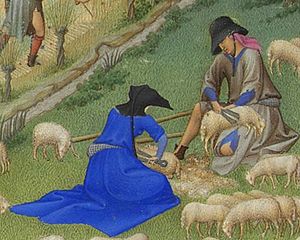
Making wool at home continued, but it became a huge business. This led to more demand for things like dyes. It also helped factories grow, boosted the banking world, and made cities bigger. Since wool was valuable and easy to move, it became a big part of trade between regions, countries, and even continents.
English wool was considered the best in medieval Europe. Especially wool from areas like the Welsh borders, the South West, and Lincolnshire. This wool was sent to busy cloth-making cities in places like the Netherlands, France, and Italy. There, new tools like the pedal-driven loom and spinning wheel helped speed up cloth production.
In 1280, England exported about 25,000 sacks of raw wool. This trade peaked with 40,000 to 45,000 sacks each year! But then it started to drop. By 1476, only about 9,700 sacks were exported. This happened because England started selling more finished cloth instead of just raw wool.
For example, in 1349–50, England exported 10,000 finished cloths per year. By 1446–47, this jumped to 60,000. And by 1539–40, it was around 140,000! By the end of the 1200s, many industrial areas in Europe really needed English wool to survive.
Challenges in the Wool Trade
The English wool trade wasn't always smooth. It was affected by many things. Wars, government taxes, and even bans on exports could cause problems. Diseases and famines also played a role. Plus, there was a lot of competition among European merchants for English wool.
For example, if England stopped exporting wool, it could cause big problems for other countries that relied on it. This made the wool trade a powerful tool in politics. Also, taxes on wool helped kings like Edward I pay for their wars. This even helped England fight the Hundred Years' War with more money than France. These ups and downs caused prices and exports to change a lot.
In the 1100s and 1200s, England mainly traded wool with Flanders (in modern-day Belgium). Flemish merchants mostly controlled this trade. But in 1264, a conflict in England called the Second Barons' War almost stopped trade with Flanders. By 1275, Italian merchants started to become more important in the wool trade. They even got involved in banking and finance in England.
Famous merchants like Jean Boinebroke from France and William de la Pole from England were part of this trade. Later, in the 1300s and 1400s, English merchants took wool cloth to Iceland. They traded it for dried fish and a coarse wool fabric called vaðmál.
Groups of textile workers, called Guilds, appeared in England earlier than in other parts of Europe. They were already active in cities like London, Winchester, and Oxford by the 1130s.
Wool Changes Over Time
By the 1500s, the quality of English wool started to decline. This might have been because farmers focused more on raising sheep for meat to feed growing cities in England. At this time, Spain and Portugal became leaders in producing fine wool, thanks to their merino sheep.
Images for kids


